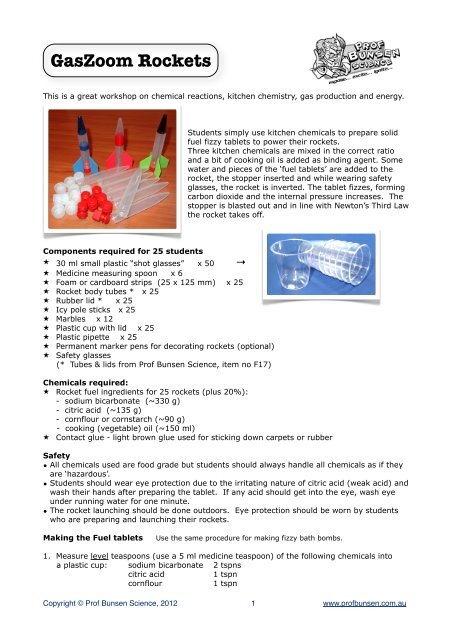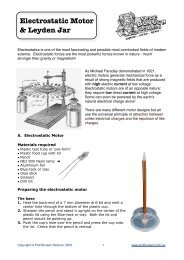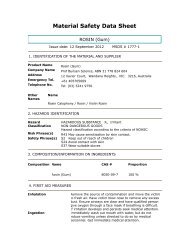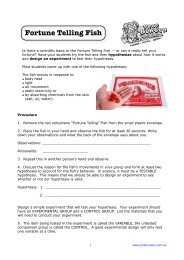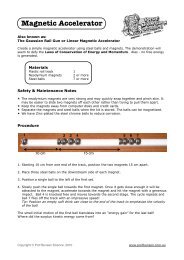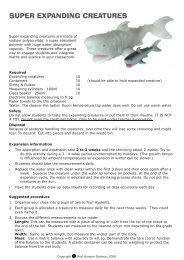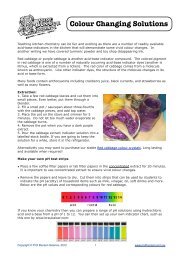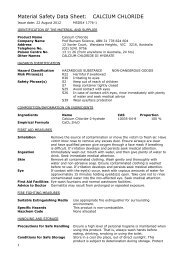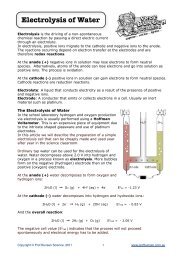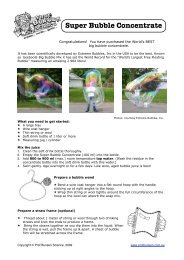GasZoom Rockets - Prof Bunsen
GasZoom Rockets - Prof Bunsen
GasZoom Rockets - Prof Bunsen
- No tags were found...
You also want an ePaper? Increase the reach of your titles
YUMPU automatically turns print PDFs into web optimized ePapers that Google loves.
<strong>GasZoom</strong> <strong>Rockets</strong>This is a great workshop on chemical reactions, kitchen chemistry, gas production and energy.Students simply use kitchen chemicals to prepare solidfuel fizzy tablets to power their rockets.Three kitchen chemicals are mixed in the correct ratioand a bit of cooking oil is added as binding agent. Somewater and pieces of the ‘fuel tablets’ are added to therocket, the stopper inserted and while wearing safetyglasses, the rocket is inverted. The tablet fizzes, formingcarbon dioxide and the internal pressure increases. Thestopper is blasted out and in line with Newton’s Third Lawthe rocket takes off.Components required for 25 students★ 30 ml small plastic “shot glasses” x 50 →★ Medicine measuring spoon x 6★ Foam or cardboard strips (25 x 125 mm) x 25★ Rocket body tubes * x 25★ Rubber lid * x 25★ Icy pole sticks x 25★ Marbles x 12★ Plastic cup with lid x 25★ Plastic pipette x 25★ Permanent marker pens for decorating rockets (optional)★ Safety glasses(* Tubes & lids from <strong>Prof</strong> <strong>Bunsen</strong> Science, item no F17)Chemicals required:★ Rocket fuel ingredients for 25 rockets (plus 20%):- sodium bicarbonate (~330 g)- citric acid (~135 g)- cornflour or cornstarch (~90 g)- cooking (vegetable) oil (~150 ml)★ Contact glue - light brown glue used for sticking down carpets or rubberSafety• All chemicals used are food grade but students should always handle all chemicals as if theyare ‘hazardous’.• Students should wear eye protection due to the irritating nature of citric acid (weak acid) andwash their hands after preparing the tablet. If any acid should get into the eye, wash eyeunder running water for one minute.• The rocket launching should be done outdoors. Eye protection should be worn by studentswho are preparing and launching their rockets.Making the Fuel tabletsUse the same procedure for making fizzy bath bombs.1. Measure level teaspoons (use a 5 ml medicine teaspoon) of the following chemicals intoa plastic cup: sodium bicarbonate 2 tspnscitric acid1 tspncornflour1 tspnCopyright © <strong>Prof</strong> <strong>Bunsen</strong> Science, 2012 1 www.profbunsen.com.au
2. Add one glass marble to the cup and cover with the lid. Shake the powder mix and marblefor one minute. (The marble breaks small lumps apart and assists with the mixing)3. Open the lid, REMOVE the marble and measure 30 drops of oil into the mix with a pipette.(If you like coloured bath bombs then you may add 2 droplets of food colouring and forbath bombs, use fragrance oil)4. Carefully transfer 10 drops of water and IMMEDIATELY MIX WITH THE STICK TO REMOVEANY FIZZING ACTION. Continue mixing for one minute. The mix should feel like wet sand.5. Pressing a fizzy tablet: Transfer about one teaspoon of the mix to a small cup andcompress this mix into the bottom of the cup using another small cup.6. Then invert the cup and tap it lightly on a sheet of paper until the tablet is released ontothe paper. Leave this to cure. It should be semi-hard within 2 hours.7. Prepare another two or three tablets in a similar way.8. Store the fuel tablets in a sealed bag or container away from moisture.Making the rocket1. Each student is provided with a foam / cardboard strip, from which the rocket’s fins arecut.2. Mark one rocket fin with a 40 mm side and a 20 mm side and cut out. Use this as templateto mark and cut another two fins.3. Insert the rubber stopper into the rocket body tube. The fins are now glued to the rocketbody tube applying the glue with a wooden stick. The fins should be spaced as evenly aspossible around the tube and should protrude down as far as the rubber stopper so it canassist in standing the rocket. Do not glue to the stopper! See photo. Leave to cure for afew minutes.4. Use permanent marker pens to decorate the rocket.Launching the rockets - outdoors!1. Break the fuel tablet into a few pieces that will fit the rocket body tube (~ 10 mm). Do notinsert into the tube yet.2. The rocket tube is marked in increments of 1 ml. Add ~ 2 ml of water to the tube.This willfill the tube to just above the nose cone.3. Safety glasses on!4. Insert two or three pieces of fuel tablet into the body tube. No need to push it down.5. Insert the stopper and check that it is pushed in as far as possible.Copyright © <strong>Prof</strong> <strong>Bunsen</strong> Science, 2012 2 www.profbunsen.com.au
6. Invert the rocket, place it as quick as possible on a stable footing and move offimmediately 3 . . . 2 . . . 1 . . . LAUNCH!The Science of the FuelSodium bicarbonate (also known a bicarb, sodium hydrogencarbonate, baking soda or bicarbonate of soda) is a weak base,with chemical formula of NaHCO3. It is used in baking as a‘leavening agent’ where it reacts with acidic compounds in thebaking mix (batter) to produce carbon dioxide which causes theexpansion of the batter - the light fluffy characteristic texture ofbaked products. Please note that sodium bicarbonate is not thesame as ‘baking powder’ but can substitute baking powder whensufficient acid reagent is added to the recipe.Citric acid is a weak organic acid. It is used to provide a sour taste to foods and softdrinks. Lemons, oranges and limes possess a high concentration of citric acid. Its chemicalformula is: C6H8O7 Combined with sodium bicarbonate, it is used to make bath fizzes oreffervescent tablets.When sodium bicarbonate and citric acid combine, water, carbon dioxide and a salt isproduced. The carbon dioxide is a gas so it requires more space and puts the pressure on thelid:Citric Acid + Sod. Bicarbonate ➜ Water + Carbon Dioxide + SaltC3OH5(COOH)3 + Na2CO3 ➜ H2O + CO2 + C3OH5(NaCOO)3Cornflour and cooking oil plays no significant chemical role in this process and are used onlyas binding agents.Have fun!Copyright © <strong>Prof</strong> <strong>Bunsen</strong> Science, 2012 3 www.profbunsen.com.au


